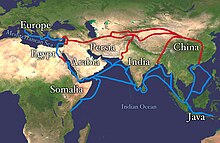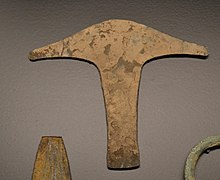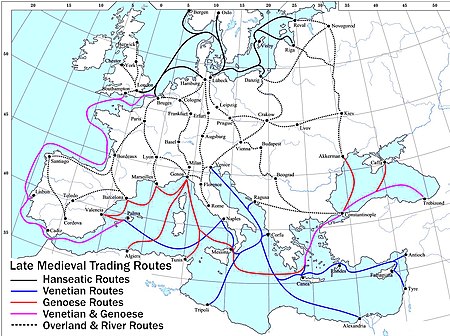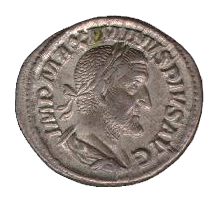Trade
Retail trade consists of the sale of goods or merchandise from a very fixed location[3] (such as a department store, boutique, or kiosk), online or by mail, in small or individual lots for direct consumption or use by the purchaser.[9] In the Mediterranean region, the earliest contact between cultures involved members of the species Homo sapiens, principally using the Danube river, at a time beginning 35,000–30,000 BP.[22][27] Networks were in existence at around 12,000 BCE[28] Anatolia was the source primarily for trade with the Levant, Iran and Egypt according to Zarins study of 1990.[41] Along the coast of the Mediterranean, researchers have found a positive relationship between how well-connected a coastal location was and the local prevalence of archaeological sites from the Iron Age.From the beginning of Greek civilization until the fall of the Roman Empire in the 5th century, a financially lucrative trade brought valuable spice to Europe from the far east, including India and China.Free trade between states was stifled by the need for strict internal controls (via taxation) to maintain security within the treasury of the sovereign, which nevertheless enabled the maintenance of a modicum of civility within the structures of functional community life.For instance, Radhanites were a medieval guild or group (the precise meaning of the word is lost to history) of Jewish merchants who traded between the Christians in Europe and the Muslims of the Near East.[52] Initiated by the indigenous peoples of Taiwan and the Philippines, the Maritime Jade Road was an extensive trading network connecting multiple areas in Southeast and East Asia.Some were also processed in Vietnam, while the peoples of Malaysia, Brunei, Singapore, Thailand, Indonesia, and Cambodia also participated in the massive trading network.[53][54][55][56] Sea-faring Southeast Asians also established trade routes with Southern India and Sri Lanka as early as 1500 BC, ushering an exchange of material culture (like catamarans, outrigger boats, sewn-plank boats, and paan) and cultigens (like coconuts, sandalwood, bananas, and sugarcane); as well as connecting the material cultures of India and China.Indonesians, in particular were trading in spices (mainly cinnamon and cassia) with East Africa using catamaran and outrigger boats and sailing with the help of the Westerlies in the Indian Ocean.This trade network expanded to reach as far as Africa and the Arabian Peninsula, resulting in the Austronesian colonization of Madagascar by the first half of the first millennium AD.The English port city of Bristol traded with peoples from what is modern day Iceland, all along the western coast of France, and down to what is now Spain.From the Middle Ages, the maritime republics, in particular Venice, Pisa and Genoa, played a key role in trade along the Mediterranean.Portuguese explorer Vasco da Gama pioneered the European spice trade in 1498 when he reached Calicut after sailing around the Cape of Good Hope at the southern tip of the African continent.[68] Beginning in the 16th century, European merchants would purchase gold, spices, cloth, timber and slaves from West African states as part of the triangular trade.Smith said that he considered all rationalizations of import and export controls "dupery", which hurt the trading nation as a whole for the benefit of specific industries.In 1817, David Ricardo, James Mill and Robert Torrens showed that free trade would benefit the industrially weak as well as the strong, in the famous theory of comparative advantage.In Principles of Political Economy and Taxation Ricardo advanced the doctrine still considered the most counterintuitive in economics: The ascendancy of free trade was primarily based on national advantage in the mid 19th century.Milton Friedman later continued this vein of thought, showing that in a few circumstances tariffs might be beneficial to the host country; but never for the world at large.Also during the war, in 1944, 44 countries signed the Bretton Woods Agreement, intended to prevent national trade barriers, to avoid depressions.[citation needed] Beginning around 1978, the government of the People's Republic of China (PRC) began an experiment in economic reform.In contrast to the previous Soviet-style centrally planned economy, the new measures progressively relaxed restrictions on farming, agricultural distribution and, several years later, urban enterprises and labor.South Korea has done much better by economic criteria than India over the past fifty years, though its success also has to do with effective state institutions.[89] Importing firms voluntarily adhere to fair trade standards or governments may enforce them through a combination of employment and commercial law.Proposed and practiced fair trade policies vary widely, ranging from the common prohibition of goods made using slave labour to minimum price support schemes such as those for coffee in the 1980s.Non-governmental organizations also play a role in promoting fair trade standards by serving as independent monitors of compliance with labeling requirements.










Trade (disambiguation)San Juan de Dios MarketGuadalajara, JaliscoGeorge Howard Earle, Jr.Business administrationAccountingManagement accountingFinancial accountingBusiness entityCorporate groupCorporation soleCompanyConglomerateHolding companyCooperativeCorporationJoint-stock companyLimited liability companyPartnershipPrivately held companySole proprietorshipState-owned enterpriseCorporate governanceAnnual general meetingBoard of directorsSupervisory boardAdvisory boardAudit committeeCorporate lawCommercial lawConstitutional documentsContractCorporate crimeCorporate liabilityInsolvency lawInternational trade lawMergers and acquisitionsCorporate titleChairmanChief business officerChief brand officerChief executive officerChief operating officerChief financial officerChief human resources officerChief information officerChief marketing officerChief product officerChief technology officerEconomicsCommodityPublic economicsLabour economicsDevelopment economicsInternational economicsMixed economyPlanned economyEconometricsEnvironmental economicsOpen economyMarket economyKnowledge economyMicroeconomicsMacroeconomicsEconomic developmentEconomic statisticsFinancial statementInsuranceFactoringCash conversion cycleInsider dealingCapital budgetingCommercial bankDerivativeFinancial statement analysisFinancial riskPublic financeCorporate financeManagerial financeInternational financeLiquidationStock marketFinancial marketFinancial institutionCapital managementVenture capitalBusiness intelligenceBusiness developmentCapacityCapabilityChangeinnovationCommercialMarketingCommunicationsConfigurationConflictContentCustomer relationshipDistributedEarned valueElectronic businessEnterprise resource planningmanagement information systemFinancialHuman resourcedevelopmentIncidentKnowledgeMaterialsNetworkadministratorOfficeOperationsservicesPerformanceProcessProduct life-cycleProductProjectPropertyQualityRecordsResourcecrisisSecurity



